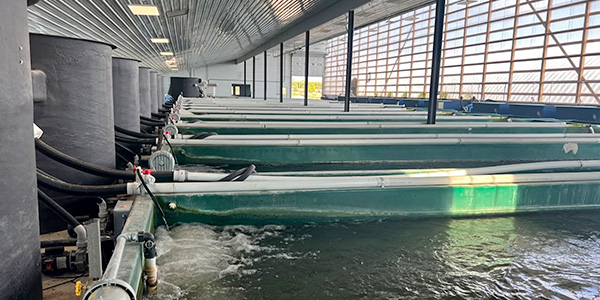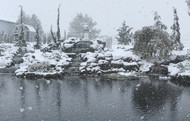The Mysterious Winter World of Koi Fish
Posted by Kloubec Koi Farm on 11th Nov 2025
Koi fish transform into remarkable survivors during winter through fascinating natural adaptations. These colorful pond dwellers produce specialized antifreeze proteins in their blood and dramatically slow their metabolism to conserve energy. When temperatures drop, koi instinctively seek deeper, more stable waters, where they remain largely motionless near the pond bottom. They reduce their food intake considerably, relying on stored fat reserves and occasional nibbles of naturally occurring algae and insects. Under the ice, koi navigate a peaceful underwater world where they drift quietly, protected by the frozen surface above. Their sophisticated winter survival strategies reveal nature's incredible engineering at work.
Winter Behavior of Koi
Koi's remarkable winter adaptations showcase their exceptional resilience during the coldest months of the year. These fascinating creatures possess a natural antifreeze property that enables them to survive harsh winter conditions, adapting their behavior to match the challenging environment. As temperatures drop, koi dormancy patterns emerge, characterized by noticeably reduced activity and a dramatic decrease in appetite.
Temperature sensitivity plays a pivotal role in their winter survival strategy, with koi becoming increasingly lethargic as the mercury dips below comfortable levels. Their energy conservation strategies are particularly impressive, as they minimize movement and rely on stored fat reserves accumulated during warmer months. While pond oxygen levels remain important, koi require less oxygen during this period due to their reduced metabolism. Winter stress factors, such as the cold and limited food availability, trigger their instinctive response to conserve energy by staying in deeper waters. Remarkably, these hardy fish maintain their ability to function at temperatures just above 4 degrees Celsius, though they rarely surface during this time. This calculated approach to winter survival demonstrates the sophisticated nature of their seasonal adaptation mechanisms.
Cold Weather Pond Care
Proper cold weather pond care encompasses three important aspects: temperature management, water quality maintenance, and predator protection. These elements work together to guarantee koi fish thrive during the challenging winter months, when their survival depends on careful oversight and strategic planning.
Implementing effective pond aeration techniques helps maintain stable water temperatures and oxygen levels, while regular water quality assessments detect potential issues before they become problematic. When necessary, fish relocation strategies may be employed during seasonal maintenance tasks, allowing for thorough cleaning and health checks. Think of it as giving your pond a winter wellness check-up!
Predator prevention measures become especially vital as hungry birds grow more desperate for food. Installing protective netting or floating covers serves the dual purpose of deterring unwanted visitors and maintaining consistent water temperatures. Smart pond owners often combine these protective elements with regular monitoring routines, creating a complete care system that adapts to changing weather conditions. Remember, just like we winterize our homes, koi ponds need similar attention to detail - it's like creating a cozy winter retreat for these remarkable underwater residents.
Feeding During Winter Months
Winter's arrival signals a notable shift in koi feeding patterns, requiring pond owners to adjust their care routines accordingly. As temperatures begin to drop, typically mid-October through mid-November, these elegant fish undergo natural metabolic changes that dramatically reduce their nutritional needs. Understanding these winter feeding routines is essential for maintaining healthy koi during the colder months. At Kloubec Koi Farm, strict health protocols guarantee peak fish care through seasonal shifts on their expansive 80-acre farm, as well as in their indoor facilities.
The key to successful koi diet adjustments lies in recognizing when to reduce feeding frequency. As their metabolism slows, koi naturally require less food, and overfeeding during this period can lead to health issues. While commercial food offerings should decrease, these resourceful fish don't completely stop eating. Instead, they turn to alternative food sources available in their environment, such as insects, algae, and small crustaceans that may still inhabit the pond. This natural foraging behavior helps supplement their reduced diet.
Pond owners should monitor water temperatures closely, as this dictates feeding schedules. When temperatures consistently fall below 50°F (10°C), it's time to scale back feeding considerably. Remember, koi are remarkably adaptable creatures, and their bodies are well-equipped to handle these seasonal changes in food availability.
Natural Winter Survival Mechanisms
Beneath the winter's chill, koi fish demonstrate remarkable biological adaptations that enable their survival during the coldest months. Through a complex system of antifreeze proteins, these resilient creatures maintain their bodily functions even as temperatures plummet around them. What's particularly fascinating is how they instinctively know when to begin their metabolic adaptation, gradually slowing down their activity as winter approaches.
- Their bodies naturally produce specialized proteins that prevent ice crystal formation in their bloodstream
- They seek out deeper sections of the pond where water temperatures remain more stable
- Their metabolic rate drops dramatically, allowing them to survive for months with minimal food intake
As koi enter their dormant state, called torpor, they position themselves near the deepest portion of the pond where temperatures hover around 39°F (4°C), their sweet spot for winter survival. This energy conservation strategy is truly remarkable - imagine going months without dinner! Their natural instincts guide them to reduce movement and settle into the warmer bottom layers of the pond, where they'll remain until spring beckons them back to the surface. It's a demonstration of nature's ingenuity that these ornamental fish have developed such sophisticated survival mechanisms.
Under The Ice
Life beneath a frozen pond surface reveals a mesmerizing world where koi fish navigate their winter sanctuary with calculated precision. Through the crystalline ice layers, these remarkable creatures maintain a delicate balance, finding refuge in the deeper regions of their aquatic home. As winter's grip tightens, koi instinctively position themselves near the pond depth's bottom, where temperatures remain more stable.
The interaction between ice layers and plant life creates a fascinating ecosystem that sustains these cold-weather survivors. While the surface may appear dormant, essential oxygen levels are maintained through a complex exchange between ice and underwater vegetation. This natural process, combined with proper water quality management, guarantees the koi's survival during the coldest months. Much like teenagers sleeping late on weekends, these colorful fish conserve energy by remaining surprisingly still, occasionally drifting upward to investigate their ice-capped world. Their strategic positioning near the bottom helps them utilize available resources efficiently while minimizing energy expenditure. The gentle dance between koi and their winter environment showcases nature's remarkable ability to adapt and thrive, even in challenging conditions.
Conclusion
Winter's embrace reveals the remarkable fortitude of koi fish, as these aquatic gems adapt to nature's coldest season with graceful resilience. Through reduced metabolism, natural antifreeze properties, and instinctive behavioral changes, koi demonstrate extraordinary survival capabilities beneath frozen surfaces. The seasonal transformation of these ornamental carp serves as both a reflection of evolutionary adaptation and a continuing source of wonder in Japanese culture, where their winter perseverance symbolizes strength through adversity.


